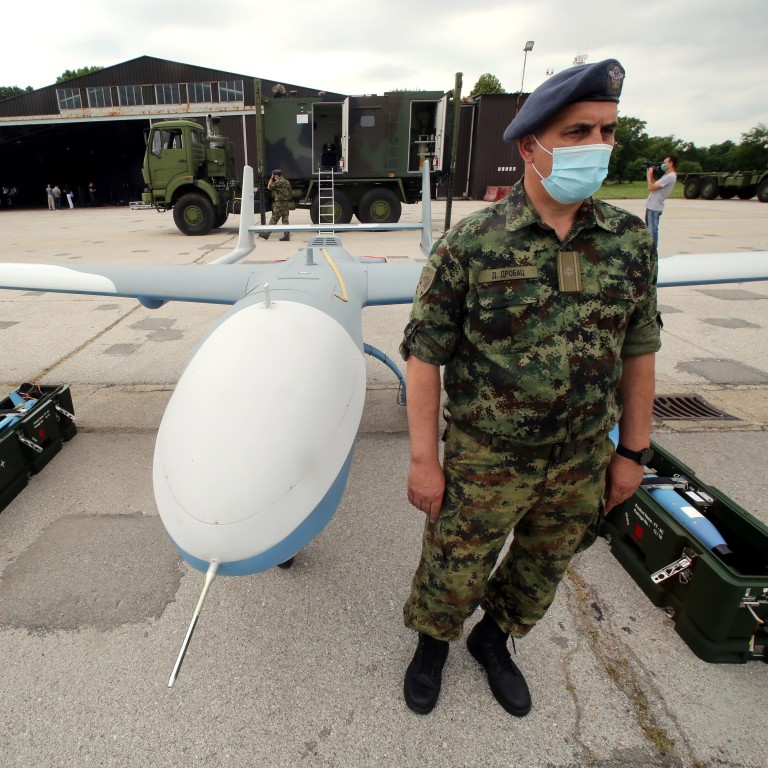
Serbian military gets reconnaissance drones and missiles from China
- It’s the first Chinese arms deal with a European country, but the value is not known
- Belgrade is trying to balance relations with Beijing, Moscow and Brussels
Six CH-92A drones and 18 FT-8C air-to-ground missiles were delivered to the Serbian Armed Forces to boost its reconnaissance capabilities, the country’s defence ministry said in a statement.
“This is becoming a modern way of warfare. In that respect we were unable and we [previously] had no chance whatsoever to compete with more serious countries,” Serbian President Aleksandar Vucic said as he inspected a military airbase in Batajnica, near Belgrade, on Saturday.
“Now we are starting, and it is important that we have agreed technology transfer with the Chinese side, so that our Pegasus can as well be slowly introduced into the system of the Serbian Armed Forces,” he said, according to the ministry, referring to drones developed by Serbia.
The value of the deal with China is not known, but Vucic said the weapons were “not expensive” and his country would buy more.

Chinese-made drones have been sent to Africa, the Middle East and neighbouring Pakistan, but this is the first time they have been sold to a European country.
The Balkan nation, which was heavily bombed by Nato during the Kosovo war in 1999 and is pushing to join the European Union, is seeking to strengthen ties with China despite unease from Europe.
Jonathan Holslag, a professor of international politics with the Vrije Universiteit Brussel, said the deal showed “the search of countries in Europe’s neighbourhood for alternative partners”.
“Arms purchases from China are also a political statement,” Holslag said.

At the time, Vucic referred to an “iron friendship” with Beijing, but he also said Serbia would not choose between China; the EU, its main trading partner; or Russia, a natural Slavic and Orthodox Christian ally.
Hong Kong-based military expert Song Zhongping said Serbia was trying to balance its relations with the three, and that was likely a factor in the Chinese arms deal.
“There is less political inference from the West, as Serbia is not a member of the EU or Nato and it’s relatively neutral with the US,” Song said. “But it’s too early to conclude that China now has an arms market in Europe.”
The deal also sheds light on China’s push to advance its military technology – particularly unmanned systems, where it has emerged as a global front-runner.

02:31
The growth of Chinese military power over the past four decades
Both the drones and the missiles were developed by state-owned China Aerospace Science and Technology Corporation, or CASC. The CH-92As are medium-altitude aircraft for reconnaissance and attack operations with a surveillance range of 250km (155 miles). They can carry two missiles, including the FT-8Cs that can reach targets 9km (5.6 miles) away.
With a relatively low price tag, Chinese-made drones are often sold to countries with a low military budget, and its Wing Loong and Caihong (CH) series have become popular exports, particularly to the Middle East and North Africa, according to a report by Washington-based think tank the Centre for Strategic and International Studies.
Could China’s unwanted FC-31 Gyrfalcon stealth fighter finally land a role in the navy?
One of China’s latest unmanned aerial vehicles is the strike-capable Caihong 5 (CH-5) Rainbow – another CASC drone that is expected to compete with the American Reaper and Israeli Heron TP.
The CASC builds some of its drones outside China, at facilities in Saudi Arabia, Pakistan and Myanmar which also serve as sales and service centres for regional buyers.
China is believed to be the second-largest arms producer in the world, behind the United States but ahead of Russia, according to the Stockholm International Peace Research Institute. But its efforts to export arms have been met with opposition from the West. In 2014, Turkey cancelled a US$4 billion order for a Chinese missile defence system after strong pressure from Washington and Nato.

